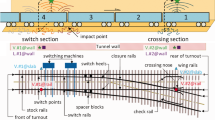Abstract
Background and Purpose
Severity of vibrations encountered in Armored Tracked Vehicles (ATV) is comparatively much higher as compared to those in wheeled vehicles. Because ATV hull structures transmit these vibrations to various mechanically connected sub-systems, the transfer of vibrations to weapon systems through the body and mechanical components makes it difficult to control the weapon stabilization system and reduce first round hit probability on the move. This paper focuses on modal analysis of an ATV hull structure for the purpose of vibration severity identification, numerical model verification, and structural optimization by a combined experimental and numerical approach.
Methods and Results
ATV experimental modal analysis is performed thorough impact, rpm sweep, and continuous run tests. Acceleration data collected from the final drives in principal directions are used in developing a reliable Finite-Element Model, based on the frequency response function (FRF). Acceleration data collected at the ATV final drives in principal directions are used in computing the forces applied to the ATV drive sprocket, based on the FRF obtained by finite-element analysis (FEA) of the ATV model. These forces are then fed-back to the Finite-Element Method (FEM) model and the numerical accelerations calculated are compared with the actual test data, indicating a high level of correlation. Next, using the FEM model that accurately predicts the actual ATV structural deformations, modal analysis of a conceptual improved design structure is carried out to demonstrate how the validated numerical model may be used to obtain significant improvements in the vehicle’s vibration characteristics.














Similar content being viewed by others
References
MIL-STD-499A United States Dept. of Defense Military Standard on Systems Engineering (1993). http://everyspec.com/MIL-STD/MIL-STD-0300-0499/MIL-STD-499_10376 (accessed 13 Mar 2022)
Tauson RA, Doss NW, Rice DJ, Tyrol DE, Davidson D (1995) The effect of vehicle noise and vibration (Caused by Moving Operations) on cognitive performance in the command-and-control vehicle. U.S. Army Res. Lab. Tech. Report ARL-MR-279. https://apps.dtic.mil/sti/citations/ADA302381 (accessed 13 Mar 2022)
Hönlinger M, Glauch Y, Steger G (2002) Modelling and simulation in the design process of Armored vehicles. In: RTO AVT Symp. on reduction of military vehicle acquisition time and cost through advanced modelling and virtual simulation. http://www.dtic.mil/dtic/tr/fulltext/u2/p014190.pdf (accessed 13 Mar 2022)
Mezyk A, Switonski W, Kciuk D, Klein W (2011) Modelling and investigation of dynamic parameters of tracked vehicles. Mech Mech Eng 15(4):115–130. http://kdm.p.lodz.pl/articles/2011/15_4_11.pdf (accessed 13 Mar 2022)
Wang X (2010) Vehicle noise and vibration refinement. Woodhead Publishing Limited, Cambridge
IEEE-STD-1220 Standard for Application and Management of the Systems Engineering Process (1999). https://doi.org/10.1109/IEEESTD.1999.88825
Butterfield T (1965) Design and development fighting tanks. Proc Inst Mech Eng 180(1):159–189. https://doi.org/10.1243/PIME_AUTO_1965_180_017_02
MIL-STD-1366E United States Department of Defense interference standard for transportability criteria (2006). http://everyspec.com/MIL-STD/MIL-STD-1300-1399/MIL-STD-1366E_2979 (accessed 13 Mar 2022)
Sacka ML (2008) A systems engineering approach to improving vehicle NVH attribute management, Master's Thesis, Massachusetts Institute of Technology, Cambridge
Marcotte T (2018) Composite rubber track trial results for warrior IFV. In: NDIA ground vehicle systems engineering and technology symposium: Power & Mobility Technical Session, Novi, MI, USA
Holmberg K, Anderssona P, Erdemir A (2012) Global energy consumption due to friction in passenger cars. Tribol Int 47:221–234. https://doi.org/10.1016/j.triboint.2011.11.022
Duan Y, Rui Q, Wang HY (2017) Analysis of tracked vehicle vibration response considering the track circuit vibration. In: 2nd International Conference on Mechanical Control and Automation, 34–39. https://doi.org/10.12783/dtetr/icmca2017/12339
MIL-STD-1472H United States Department of Defense design criteria standard: human engineering (2020). http://everyspec.com/MIL-STD/MIL-STD-1400-1499/MIL-STD-1472H_57041, (accessed 13 Mar 2022)
Sun W, Zhou J, Gong D, You T (2016) Analysis of modal frequency optimization of railway vehicle car body. Adv Mech Eng 8(4):1–12. https://doi.org/10.1177/1687814016643640
He J, Fu ZF (2001) Modal analysis. Butterworth Heinemann, Oxford
Imregun M, Visser WJ, Ewins DJ (1995) Finite element model updating using frequency response function data—I. Theory and initial investigation. Mech Syst Signal Process 9(2):187–202. https://doi.org/10.1006/mssp.1995.0015
Anas K, David S, Babu RR, Selvakumar M, Chattopadhyay S (2018) Energy dissipation characteristics of crosslinks in natural rubber: an assessment using low and high-frequency analyzer. J Polym Eng 38:723–729. https://doi.org/10.1515/polyeng-2016-0425
Dasch HM, Gorsich DJ (2016) Survey of modular military vehicles: benefits and burdens. Defense Acquis Res J 23(1):2–27. https://apps.dtic.mil/sti/pdfs/AD1015742.pdf (accessed 13 Mar 2022)
Acknowledgements
The authors gratefully acknowledge the support of Otokar Automotive Defense Industry Inc. through co-author’s Ph.D. research.
Author information
Authors and Affiliations
Corresponding author
Ethics declarations
Conflict of Interest
Authors confirm that the intellectual content of this paper is the original product of our work and all the assistance or funds from other sources have been acknowledged. The authors declare that they have no conflict of interest.
Additional information
Publisher's Note
Springer Nature remains neutral with regard to jurisdictional claims in published maps and institutional affiliations.
Rights and permissions
Springer Nature or its licensor (e.g. a society or other partner) holds exclusive rights to this article under a publishing agreement with the author(s) or other rightsholder(s); author self-archiving of the accepted manuscript version of this article is solely governed by the terms of such publishing agreement and applicable law.
About this article
Cite this article
Zafer, N., Aybar, U. Vibration Analysis and Optimization of a Tracked Armored Vehicle. J. Vib. Eng. Technol. 11, 3177–3184 (2023). https://doi.org/10.1007/s42417-022-00739-x
Received:
Revised:
Accepted:
Published:
Issue Date:
DOI: https://doi.org/10.1007/s42417-022-00739-x




